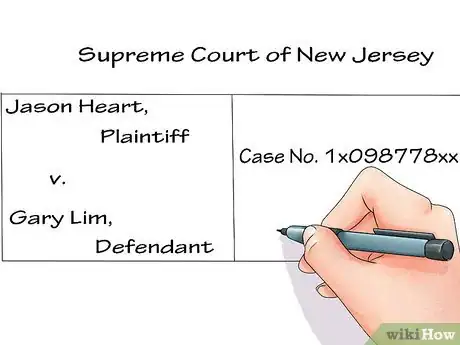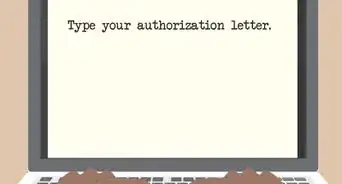This article was co-authored by Clinton M. Sandvick, JD, PhD. Clinton M. Sandvick worked as a civil litigator in California for over 7 years. He received his JD from the University of Wisconsin-Madison in 1998 and his PhD in American History from the University of Oregon in 2013.
wikiHow marks an article as reader-approved once it receives enough positive feedback. This article has 13 testimonials from our readers, earning it our reader-approved status.
This article has been viewed 2,070,354 times.
An affidavit is a written statement that has been notarized. If you need an affidavit for a court case or other legal reasons, preparing one is easy if you know the guidelines.
Steps
Including the Basics
-
1Insert a case caption. If you're preparing the affidavit to be submitted as part of a court case, the heading at the top of the affidavit document should be the case caption, which identifies the case in question. Formatting the case caption properly will ensure your affidavit is recognized by the attorneys, prosecutors and legal clerks.
- To create a case caption, start by creating a centered heading that identifies the court venue. For example, "Supreme Court of New Jersey."
- Next write the names of the defendants and plaintiffs, positioned below and to the left of the heading. If you do not know the names, find a copy of another legal document filed in the case, such as the complaint.
- Write the case number and position it below the heading, to the right.
-
2Title your statement. Write the word "Affidavit" just below the caption, in the center of the page. If your document does not include a case caption, "Affidavit" should appear centered at the top of the page.Advertisement
-
3Write the state and county. These should be left-aligned, with the state appearing above the county.
-
4Identify the affiant. This part of the affidavit is called a "commencement," and it's where the full name of the affiant (the person making the statement for the affidavit) should be listed. This part is commonly worded as follows: "Comes now [affiant's first and last name] and states as follows:"[1]
- If the affidavit is for a court case, the statement should read, "Comes now [affiant's first and last name], being first duly sworn, under oath, and states as follows:"
-
5Include relevant personal information. Certain types of affidavits require information about the affiant, other than his or her name. This information appears in the first paragraph, numbered "1," and may include:[2]
- The address of the affiant. If the address of the affiant is important to the facts described and sworn to, it should be included in the affidavit. For example, when signing an affidavit of residence for the Bureau of Motor Vehicles ("BMV") so that your child may obtain a driver's license, you are swearing that your child lives with you within the state. Therefore, your address is important to the facts of the affidavit and should be included.
- The age or date of birth of the affiant. The age and/or date of birth of the affiant should be included in the affidavit if it is relevant to the subject matter. For example, when circumstances require that the affiant be a certain age, such as when inheriting from a trust fund that requires him or her to have reached the age of 25 to receive the inheritance, then age should be included.
- The occupation of the affiant. The occupation of the affiant should be included when the affiant is signing as an expert or qualified person. For example, a doctor testifying in a malpractice case as an expert witness or a mechanic certifying the cost of repairs to a car would want to include their occupation.
- The immigration status of the affiant. When providing an affidavit to support an immigration petition, you should include the affiant's own immigration status.
- The relationship of the affiant to the litigant(s). The relationship of the affiant to one or more parties involved in a lawsuit should be included when the affidavit will be used in connection with the suit.
Writing the Statement
-
1Describe the facts in a numbered list. You may include as many or as few facts in an affidavit as necessary. When describing the facts you should:[3]
- Use the first person. For example: "I am the owner of Jane Doe Salon, located in Springfield, Massachusetts."
- State each one in a separate paragraph. Each paragraph of the affidavit should include one fact or a small number of facts if one cannot be stated alone.
- Number your paragraphs. This will make it easier to read and reference in Court or in other documents.
- Describe each fact clearly and concisely, providing names, dates, addresses, and other supporting information as needed.
- Use only first-hand information that you can personally verify; do not use speculation or information that you've heard from someone else.[4]
- Refer to supporting documents, photographs, or other tangible paper items which can be attached to the affidavit, and attach them. For example, if describing a photograph in the affidavit, state that a copy of the photograph is attached and marked as "Exhibit A" or “Exhibit 1.” Then write "Exhibit A" or “Exhibit 1” on a copy of the photograph and staple it to the completed affidavit. Exhibits may be lettered or numbered and should be labeled according to the order in which they are mentioned in the affidavit.
-
2Write a statement of truth. Make a clear statement that the affidavit is a complete representation of the facts to which the affiant is swearing. This assures readers that the affidavit is not a partial statement and that it includes all of the information the affiant has on the subject. It is common in the U.S. to end an affiant's statement with the sentence, "Further Affiant sayeth not."
-
3Spell out the oath that the affiant is taking. An affiant in the United States generally writes an affidavit "under pains and penalties of perjury." This means that the affiant may be charged with lying under oath if he or she makes any false statement within the affidavit.
- Consequently, it is very important to include only information that you know to be true. Never include false information in an affidavit. The consequences could include prosecution and imprisonment.[5]
-
4Create a signature block. Provide a space for the affiant's signature, with his or her typed or printed name below, and a space to fill in the date of signing. This will be completed in the presence of a notary.
-
5Include a court clerk or notary signature block. The end of the affidavit should include a statement by a court clerk or notary public, or another official authorized to administer an oath. The statement should say that the affiant appeared before the court clerk or notary, swore to the above statements, and showed legal identification. The affidavit must be signed by the affiant in front of the court clerk or notary and include the notary's signature and stamp.
- You must bring sufficient identification and show it to the notary in order to establish that you are who you claim to be. For example, you should bring either a valid driver's license or passport.[6]
- A minor may sign an affidavit. However, the minor must appear before the notary.[7] If the child does not have an acceptable government-issued ID (such as a passport), then witnesses must appear and give an oath as to the child's identity. The number of necessary witnesses is decided by state law.[8]
Sample Affidavit
Warning
- By signing the affidavit, the subject is making an oath of honesty. All facts within the document must be true. If they are found to be false, the person making the statement may be punishable by law and guilty of perjury.
References
- ↑ http://homeguides.sfgate.com/write-legal-affidavit-1145.html
- ↑ http://thelawdictionary.org/article/how-to-write-an-affidavit/
- ↑ http://homeguides.sfgate.com/write-legal-affidavit-1145.html
- ↑ http://oregonlawhelp.org/files/CCDACC15-944D-570E-7F1F-7BBF3DEC0018/attachments/38BAAA60-B406-454C-B5DE-0D9256550E6D/491241How%20to%20Write%20an%20Affidavit2006(reviewed%206-10).pdf
- ↑ http://www.criminaldefenselawyer.com/crime-penalties/federal/perjury.htm
- ↑ http://www.nolo.com/legal-encyclopedia/free-books/fiance-marriage-visa-book/chapter4-16.html
- ↑ http://members.usnotaries.net/news.asp?AssetID=615
- ↑ http://members.usnotaries.net/news.asp?AssetID=615
About This Article
If you’re preparing an affidavit for a court case, you will need to identify the person making the statement, or the affiant, and any relevant personal information about them. Then, describe the facts of the case in a numbered list and finish with a statement of truth and the oath the affiant has taken. Provide a space for the affiliant’s signature and the court clerk or notary signature block. Keep reading to learn how to format the heading for your affidavit!










































































